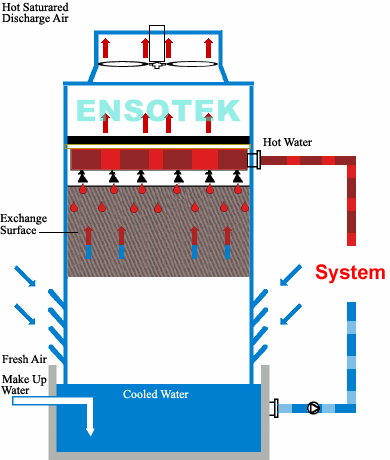How does a wet cooling tower work ?
Cooling towers are divided as counter flow and cross flow towers according to operating principles. In counter flow cooling towers, the water flows top-down while the air moves from down-top. In cross flow cooling towers, while the water fall top-down, air current is horizontal. In recent years, forced draft counter flow towers has being preferred.
In counter flow induced draft type cooling towers, heated water, coming from facility, is homogenously sprayed to all section of tower in top-down with the help of specially manufactured waterworks system and fountains. Sprayed water mass falls into pieces by floating in tower fills. Air, having the humidity of exterior environment, is absorbed from down to top on fills with the help of motor fan group. Water, meeting the air on the inlay cooling surface, heats input to the air and a part of it cools by vapouring. Cool water is sent to facility by gathering in tower cold water basin. Air, whose humidity rises (close to saturation point) as result of vapouring, is thrown to atmosphere from the fan deck at the top of tower.
According to thermodynamic facts; for achieving each gram water’s phase change, nearly 540 cal/energy is absorbed from the system.
With this approach; for each 6 ºC cooling of water, circulating in the system, nearly %0,9 of water flow rate must vapour. This amount can be calculated with formula above:
Vapouring Amount(m³/h) = 0.00085 x 1.8 x Flow (m³/h) x (Tin—Tout)





